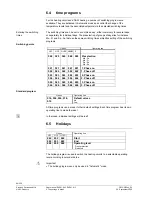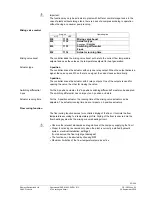
Important:
The function may only be activated in plants with buffer or combi storage tanks. In the
case of plants without storage tank, there is a risk of a compressor being in operation
without having a consumer pump running.
Mixing valve control
Line no.
Operating line
HC1
HC2
830
1130
Mixing valve boost
832
1132
Actuator:type
2-position ¦ 3-position
833
1133
Switching differential
2-pos
834
1134
Actuator running time
Mixing valve boost
The controller adds the mixing valve boost set here to the current flow temperature
setpoint and uses the value as the temperature setpoint for heat generation.
2-position
Actuator:type
The controller drives the actuator with only one relay output. When the output delivers a
signal, the valve opens. When there is no signal, the valve closes automatically.
3-position
The controller drives the actuator with 2 relay outputs. One of the outputs is used for
opening the valve, the other for closing the valve.
For the 2-position actuator, the "2-position switching differential" must also be adapted.
The switching differential has no impact on 3-position actuators.
Switching differential
2-pos
For the 3-position actuator, the running time of the mixing valve actuator can be
adjusted. The actuator running time has no impact on 2-position actuators.
Actuator running time
Floor curing function
The floor curing function serves for controlled drying of the floor. It controls the flow
temperature according to a temperature profile. Drying of the floor is ensured via the
floor heating system by the mixing or pump heating circuit.
•
Observe the relevant standards and regulations of the company supplying the floor!
•
Proper functioning is ensured only when the plant is correctly installed (hydraulic
system, electrical installation, settings)!
If not observed, the floor might get damaged!
•
The function can be aborted by choosing
Off
.
•
Maximum limitation of the flow temperature remains active
93/258
Siemens Switzerland Ltd
User manual RVS61.843, RVS41.813
CE1U2355en_02
HVAC Products
6 The settings in detail
28. September 2009
















































